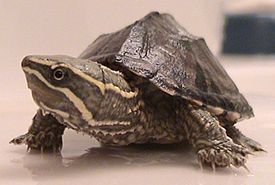
Musk turtle (Photo by Dawson)
Eastern musk turtle
Sometimes referred to as the "stinkpot" turtle, this species emits a strong odour, especially when it is frightened
What does the eastern musk turtle look like?
These are small freshwater turtles measuring a maximum carapace (upper shell) length of 15 centimetres. Their arched, narrow carapaces are grey, brown or black. Musk turtles can be identified by the two light stripes on either side of their head and two barbels (fleshy projections) under the chin, similar to a catfish.
.
Where does the eastern musk turtle live?
Eastern musk turtles can be found in southern Ontario and a few locations in southwestern Quebec. They live in shallow rivers, lakes and ponds with a slow current and soft bottom for winter hibernation. Nesting habitat is close to the water and exposed to direct sunlight, including shorelines, decaying vegetation or muskrat lodges.
What is the eastern musk turtle's conservation status?
Eastern musk turtles are assessed as special concern by the Committee on the Status of Endangered Wildlife in Canada. Wetland habitat loss, shoreline development, pollution and recreational activities (mortality from motorboat collisions and fishing traps) threaten this species.
What is NCC doing to protect the eastern musk turtle's habitat?
The Nature Conservancy of Canada (NCC) is protecting and restoring the eastern musk turtle’s habitat on our properties throughout southern Ontario. In Quebec, NCC has conserved properties where eastern musk turtle occur, along the Ottawa river in the Outaouais region.





